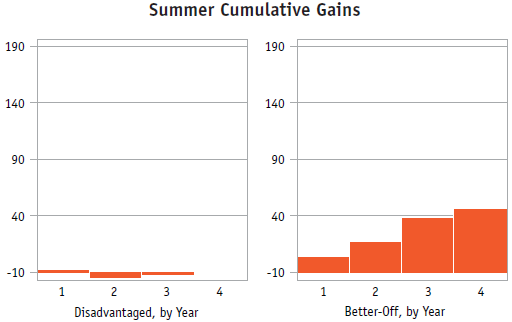"Them That Has, Gets"
It is a phrase that summarizes well a rule in organic chemistry, Markovnikov's rule, the carbon that has more hydrogen gets the hydrogen. Sadly, this rule likewise applies to basic education. Achievement and skill gaps between poor and rich children are already present even before kindergarten. And it has long been accepted that these gaps only grow with years of schooling. A study that started in 1982 even demonstrates that the difference between disadvantaged and better-off students grow during the summer months.
Recently, Paul T. von Hippel and Caitlin Hamrock have questioned the validity of the summer learning loss. In a study published in the journal Sociological Science, these authors conclude that the summer learning loss is simply an artifact of how children are tested.
Kelly Chandler-Olcott, Laura J. & L. Douglas Meredith Professor for Teaching Excellence, Syracuse University writes in The Conversation:
 |
| Above copied from Summer Can Set Kids on the Right—or Wrong—Course |
Recently, Paul T. von Hippel and Caitlin Hamrock have questioned the validity of the summer learning loss. In a study published in the journal Sociological Science, these authors conclude that the summer learning loss is simply an artifact of how children are tested.
Interesting to note is the quote at the beginning of the article, "Give me a child until the age of seven, and I will give you the man." In this paper, the authors actually suggest "that reading and math gaps grow substantially more in the first five years of life than they do in the nine years after school begins". The authors do qualify this statement later in the paper by stating that "the finding that gaps emerge in early childhood does not mean that nothing can be accomplished later on". The paper correctly illustrates the problems with using standardized test scores as ways to measure learning gaps. Standard deviations are tricky since the absolute numbers are lost in the analysis. Take, for instance, income. One can use standard deviations or the actual amount of money an individual makes. At age 22, here is the income distribution:
 |
| Above obtained from DQYDJ |
One standard deviation in the above distribution is about $5,000. Here is the income distribution at age 31:
 |
| Above obtained from DQYDJ |
Here, one standard deviation is roughly $11,000, twice as much as the amount at age 22. Measured in terms of standard deviation, the difference is deceivingly identical, but in absolute amounts, the difference is actually doubled. Like income, both knowledge and skills are expected to grow with time. Measuring gaps in terms of standard deviation or absolute terms can make a huge difference. Children given the privilege of enriching opportunities during summer have an advantage over those who are not as fortunate. This is a fact and no test score or data analysis should be able to refute this.
It is fruitless to resign to the gaps that are present at the beginning of kindergarten but it is even more tragic to dismiss summer learning loss. Due to the huge difference between rich and poor parents, and between highly educated and non-educated parents, educators simply cannot stand on the sideline.
I believe that solutions to the summer slide should not fall predominantly on students and their families. Instead, schools must step up to design summer-learning supports responsive to community needs. These might be home-based initiatives, such as the one created by Richard Allington and colleagues, where students’ selection and ownership of 12 free books yielded small but significant gains in reading, particularly for students from the least-advantaged families. Schools might also offer no- or low-cost programs on site that combine interest-driven academics with a mix of enrichment activities such as dance, drama, or meditation. Summer school can be much more than the retaking of failed courses.

Comments
Post a Comment